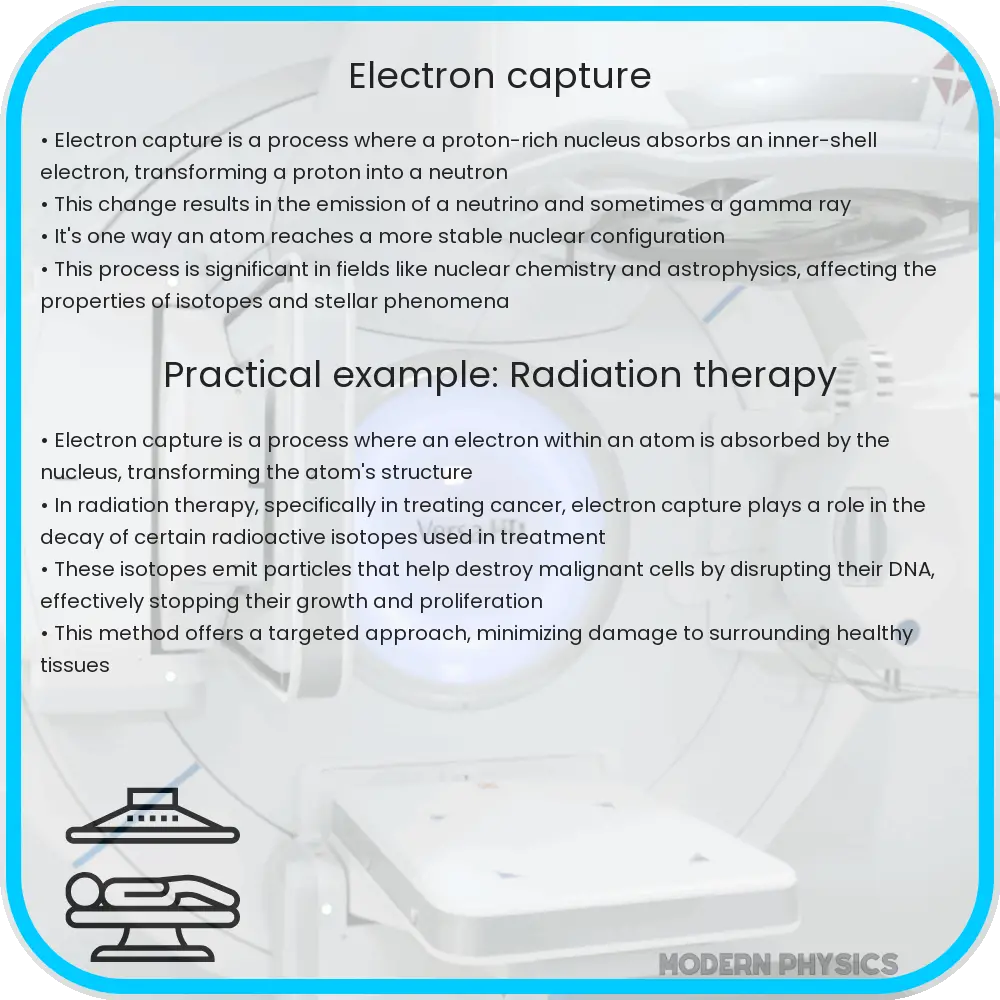Explore the process of electron capture in nuclear physics, where an inner shell electron is absorbed by the nucleus, transforming a proton into a neutron and emitting a neutrino.

Understanding Electron Capture
Electron capture is a fascinating and crucial process in nuclear physics where an electron from an atom’s inner shell is captured by the nucleus. This interaction leads to a transformation within the nucleus that has significant implications, both in natural phenomena and practical applications. In this article, we’ll explore the basics of electron capture, including its process, examples, and uses.
The Process of Electron Capture
Electron capture occurs when an atom’s nucleus captures one of its own electrons, typically from the innermost shell (the K-shell). When this happens, a proton in the nucleus transforms into a neutron. Simultaneously, a neutrino is emitted from the nucleus. The overall effect of this process can be summarized by the following equation:
\[ p + e^- \rightarrow n + \nu_e \]
Here, \( p \) represents a proton, \( e^- \) is an electron, \( n \) stands for a neutron, and \( \nu_e \) denotes a neutrino. This transformation changes the atomic number of the element, thereby changing the element itself, though the mass number remains the same.
Examples of Electron Capture
Electron capture is a common decay mode for many isotopes that are proton-rich. One of the classic examples of electron capture is observed with Potassium-40 (\(^{40}K\)). Potassium-40 can undergo electron capture to form Argon-40 (\(^{40}Ar\)):
\[^{40}_{19}K + e^- \rightarrow ^{40}_{18}Ar + \nu_e\]
This transmutation plays a crucial role in geological dating, particularly in the dating of rocks and minerals. Another example involves Beryllium-7 (\(^7Be\)), which captures an electron to become Lithium-7 (\(^7Li\)), a process important in nuclear astrophysics.
Uses of Electron Capture
Electron capture has practical applications in various fields. In medicine, it is used in radioisotope imaging and therapy. For instance, the isotope Iodine-125, which decays by electron capture, is used in cancer treatment, especially in the treatment of prostate cancer. Electron capture is also employed in environmental science to detect trace amounts of pollutants, using the decay signature of specific isotopes. In the field of astrophysics, studying electron capture helps scientists understand the processes that fuel stars and the formation of elements in the universe.
How Electron Capture is Detected
Detecting electron capture involves observing the byproducts of the process, particularly X-rays and Auger electrons released as the atom reorganizes its electrons. These emissions are characteristic of the atom involved and can be measured using spectroscopy techniques, allowing scientists to study both the process and the stability of isotopes that undergo electron capture.
Conclusion
The discussion on electron capture demonstrates its importance in shaping our understanding of the physical world, from minute atomic structures to grand cosmic phenomena.
Understanding Electron Capture
Electron capture is a fascinating and crucial process in nuclear physics where an electron from an atom’s inner shell is captured by the nucleus. This interaction leads to a transformation within the nucleus that has significant implications, both in natural phenomena and practical applications. In this article, we’ll explore the basics of electron capture, including its process, examples, and uses.
The Process of Electron Capture
Electron capture occurs when an atom’s nucleus captures one of its own electrons, typically from the innermost shell (the K-shell). When this happens, a proton in the nucleus transforms into a neutron. Simultaneously, a neutrino is emitted from the nucleus. The overall effect of this process can be summarized by the following equation:
\[ p + e^- \rightarrow n + \nu_e \]
Here, \( p \) represents a proton, \( e^- \) is an electron, \( n \) stands for a neutron, and \( \nu_e \) denotes a neutrino. This transformation changes the atomic number of the element, thereby changing the element itself, though the mass number remains the same.
Examples of Electron Capture
Electron capture is a common decay mode for many isotopes that are proton-rich. One of the classic examples of electron capture is observed with Potassium-40 (\(^{40}K\)). Potassium-40 can undergo electron capture to form Argon-40 (\(^{40}Ar\)):
\[^{40}_{19}K + e^- \rightarrow ^{40}_{18}Ar + \nu_e\]
This transmutation plays a crucial role in geological dating, particularly in the dating of rocks and minerals. Another example involves Beryllium-7 (\(^7Be\)), which captures an electron to become Lithium-7 (\(^7Li\)), a process important in nuclear astrophysics.
Uses of Electron Capture
Electron capture has practical applications in various fields. In medicine, it is used in radioisotope imaging and therapy. For instance, the isotope Iodine-125, which decays by electron capture, is used in cancer treatment, especially in the treatment of prostate cancer. Electron capture is also employed in environmental science to detect trace amounts of pollutants, using the decay signature of specific isotopes. In the field of astrophysics, studying electron capture helps scientists understand the processes that fuel stars and the formation of elements in the universe.
How Electron Capture is Detected
Detecting electron capture involves observing the byproducts of the process, particularly X-rays and Auger electrons released as the atom reorganizes its electrons. These emissions are characteristic of the atom involved and can be measured using spectroscopy techniques, allowing scientists to study both the process and the stability of isotopes that undergo electron capture.
Conclusion
The discussion on electron capture demonstrates its importance in shaping our understanding of the physical world, from minute atomic structures to grand cosmic phenomena. This process not only provides insights into elemental transformations but also has significant applications ranging from healthcare to environmental monitoring. Understanding electron capture facilitates deeper appreciation and comprehension of the dynamic interactions at the heart of matter, highlighting the intricate balance of forces that govern the universe.
